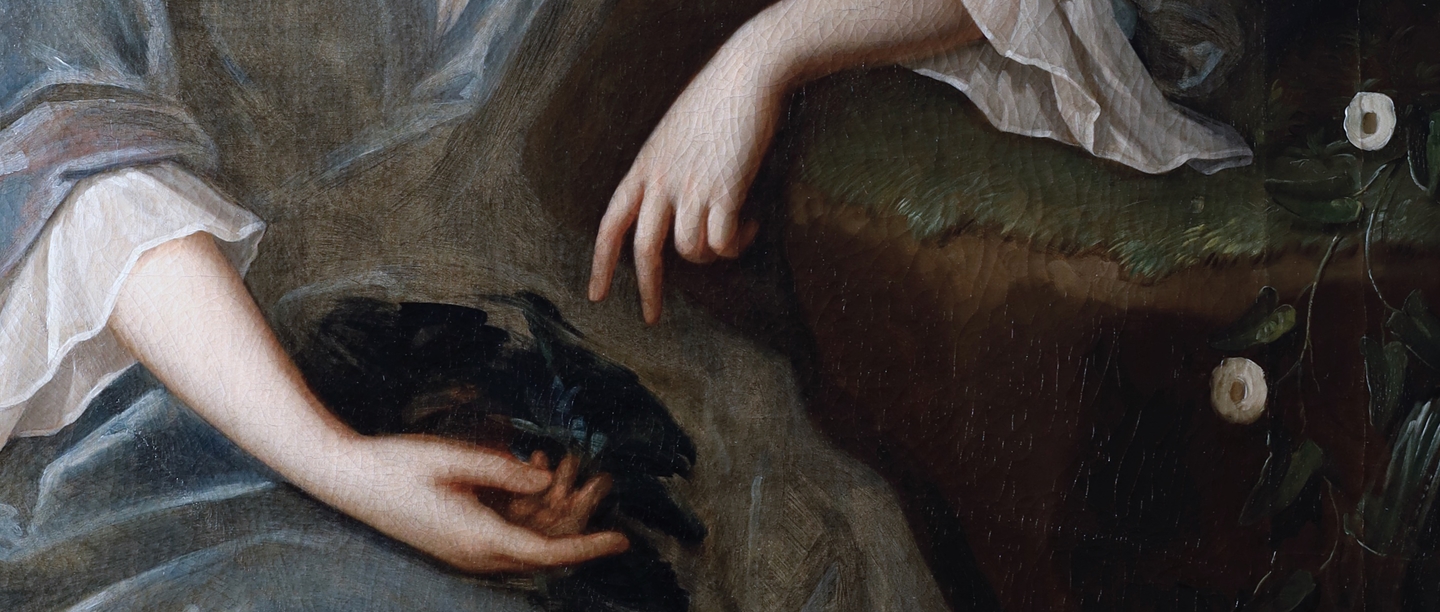A Family of Painters
From a Dutch family, Maria Verelst was born in Vienna where her father, Herman Verelst (1641–1702), was working as Painter to the Emperor. When the city was besieged by the Ottomans in 1683, the family fled to England. There, Herman and his children, Cornelis and Maria, established themselves as professional painters.
Maria was multilingual and was a languages teacher as well as a painter, which helped her cultivate a diverse and prominent clientele in cosmopolitan London. She was commissioned by the likes of the Duke of Chandos and the Cornwallis family, suggesting she found favour in the highest echelons of society.
Little is known about the rest of Verelst’s life, except for a (possibly apocryphal) story that illustrates her gumption; a quality likely necessary to fight her way through the coffee houses and masculine bravado of the 18th-century London art scene. One evening at the theatre, Verelst overheard two men excitedly discussing her appearance in German. She interrupted them, chastising them for their lewd comments, whereupon they apologised, but continued their discussion in Latin. Also being fluent in Latin, Verelst interrupted them again. The men were so impressed that they properly made her acquaintance, and each commissioned a portrait from her.
Audley End Portraits
Three of Verelst’s portraits are on display at Audley End House. These are of Charles, 4th Baron Cornwallis (1675–1722); his wife, Lady Charlotte, née Butler (1679–1725); and his half-sister Isabella Scott (1690–1748). Charles was a Whig politician and member of the famous political club, the Kit-Cat Club. He married Charlotte Butler in 1699 and they had ten children. Isabella Scott was the daughter of Charles’s father, the 3rd Baron Cornwallis (1655–98), and Lady Anne Scott (1651–1732), the Duchess of Buccleuch. Lady Anne Scott was an heiress in her own right, so all of her children took her surname.
It is likely Verelst gained this commission through another one of her wealthy landowning patrons – the Townshends of the Raynham Estate in Norfolk. Verelst had painted several members of the Townshend family, two of whom went on to marry children of Charles and Charlotte Cornwallis, including their heir. The two families were friends through their mutual Whig political interests.
The half-length portraits by Verelst were first recorded in the Audley End collection in 1836 by the owner Richard Neville, 3rd Baron Braybrooke (1783–1858). The paintings came into the collection as a result of his marriage to Lady Jane Cornwallis (1819), Charles and Charlotte’s great-great-granddaughter. Lady Jane had inherited a number of family portraits including the three by Verelst and brought them to be displayed at Audley End.
Read about the conservation of Lady Jane’s family portraitsProcess and Technique
Verelst painted in a formulaic and stylised manner that makes her paintings identifiable. It was common for artists at this time not only to have studio props and outfits to arrange for their sitters, but also to use set compositions and poses. The set pieces allowed the painter to reduce the amount of time spent on observation and compositional decision-making, leaving extra time to concentrate on the more important parts of the painting, such as the facial likeness. In larger studios the artist may only have painted the face, while compositional elements were left to assistants or drapery and background painters.
Nothing is known about Verelst’s studio set-up or whether she had assistants, but this compositional pick-and-mix technique is evident in the Cornwallis portraits. Comparing the portraits of Lady Charlotte and Lady Isabella, the paintings are almost identical in composition; the only differences are the colour of the dresses and the lower neckline in Isabella’s portrait, which is, in fact, a later adjustment. Both paintings have the same configuration of foliage and the same architectural feature in the background, and the sitters even sit in the same pose.
Verelst painted within the technical norms of the late 17th and early 18th centuries. But there are areas of her approach that are unique. For example, when breaking down the layers of paint in the portrait of Lady Charlotte, we can see that after laying in the base colour and shadows for the sitter’s dress, Verelst added distinct white highlights. The boldness of the highlight layer is unique to Verelst – other artists might have blended them or used more subtle tones. Instead, Verelst relied on a coloured translucent glaze which she layered over the whole piece of clothing to help unify the tones. This technique, which is seen in all three portraits, suggests that Verelst had a formulaic approach to painting where speed and efficiency were the priorities.
Unfortunately, over time the pigments in the glazing layers of the portraits have deteriorated, so the starkness of the highlights is now quite prominent. But beneath the frame rebate (the area of the frame that covers part of the painting), the portrait of Charlotte has been protected from light damage and the rich red of the glaze is still visible, hinting at what the painting might have looked like originally.
Blue Pigments
In the portraits of Charles and Isabella, the blue clothing was painted using a combination of ultramarine, smalt and indigo. In the case of Isabella, ultramarine and indigo were mixed for the opaque base layer in the dress, while the glazing layer was made of smalt. Ultramarine was made from lapis lazuli mined in Afghanistan. It was as valuable as gold and has been prized for its richness and rarity throughout human history.
Smalt was a cheaper and cooler-toned blue pigment made from powdered glass. It was popular during the latter half of the 17th century although it fell out of favour during the 18th century. It made a translucent paint which was good for glazing.
Caribbean plantations of the Indian indigo plant rose in number in the late 17th Century. This plant had a higher colour yield than the European variant and indigo became more frequently used as a painter’s pigment from around this time. It had previously been used primarily as a textile dye. Indigo was farmed and processed by enslaved people, some of whom had been specifically chosen by their masters for their knowledge of indigo processing, making the masters exceedingly wealthy.
Indigo pigment fell out of use in oil paints after the invention of Prussian Blue, which became available in Britain in the 1740s; but indigo continued to be produced in large quantities for textiles in the Caribbean and, later, Bengal under British colonial rule. Indigo’s presence in the painting of Isabella is lasting evidence of the omnipresence of colonialism and the transatlantic slave trade in British life.
A Woman Artist
The three paintings by Maria Verelst at Audley End provide insight into early 18th-century painting practice and the materials available to artists; but they also encapsulate a snippet of this professional woman artist’s working life. Having an artistic career at this time was prohibitively difficult for women because academic training, professional spaces and societies were reserved for men. Being born into an artist’s family and being highly educated gave Verelst the knowledge and skills to develop a paying practice. Her absence from documentation and records, partly due to her gender, along with not signing her works has resulted in her works being frequently misattributed to her male contemporaries. Identifying her characteristic techniques, style and compositions will help specialists identify her works and shed light on her life.
By Alegria Spencer
Explore More
-
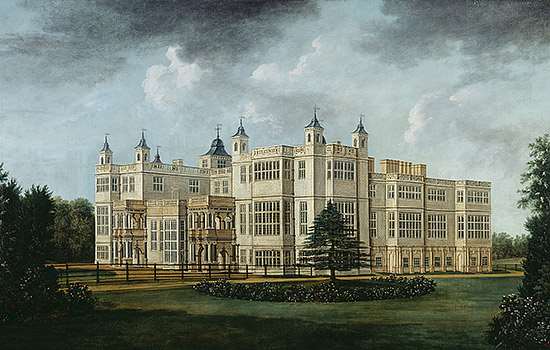
Audley End’s Collection Highlights
View detailed images of some highlights from the diverse collection at Audley End – from paintings to natural history tableaux.
-
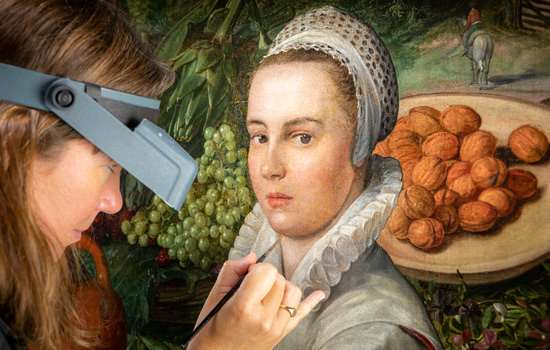
The Vegetable Seller
With new conservation work, technical analysis and research, we have been able to uncover some of the secrets of this mysterious painting which had been languishing in the back of a store room at Audley End for over 40 years.
-
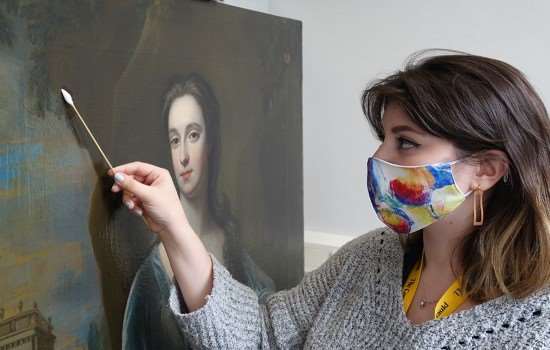
Portrait Conservation at Audley End
In 2020–23 we welcomed students from the Courtauld Institute of Art to help conserve five 17th- and 18th-century portrait paintings from the collection at Audley End House. Read more about these challenges, the paintings and their conservation.
-
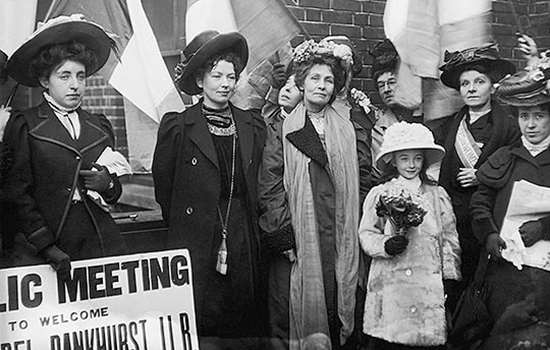
Women in History
Read more about the women that shaped the course of English history, from great queens, writers and scientists, to those that broke the mould or remain largely unnamed.
